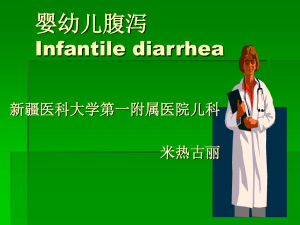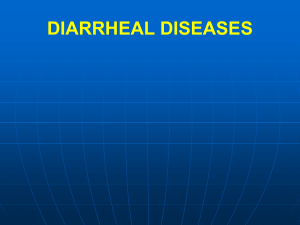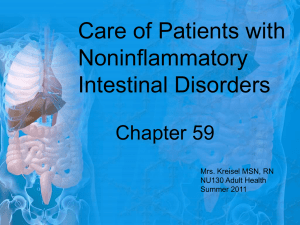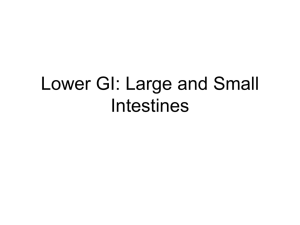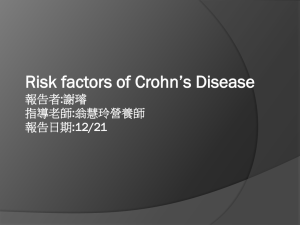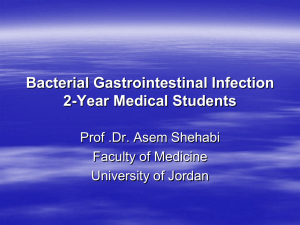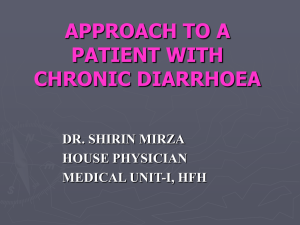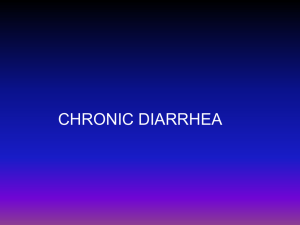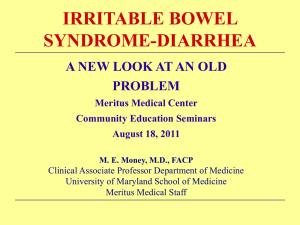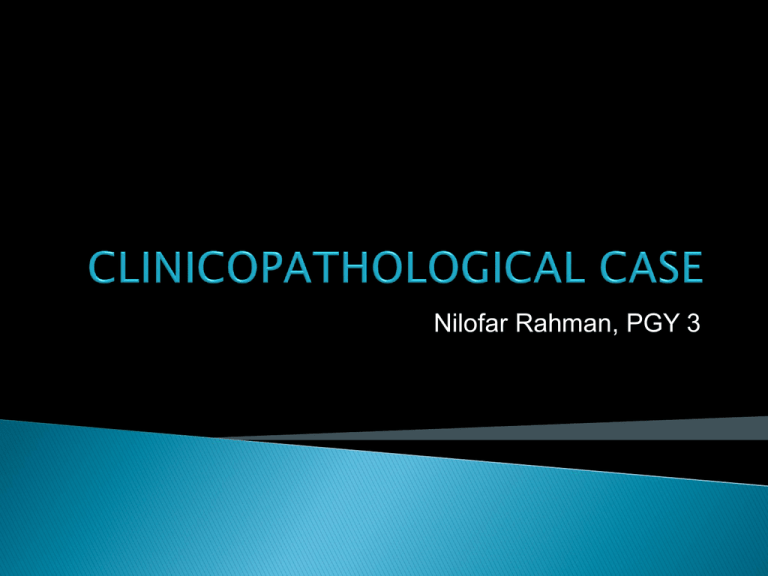
Nilofar Rahman, PGY 3
43 y/o Caucasian M presented with c/o intermittent diarrhea for last 1
month, associated with lower abdominal cramps.
Stools are liquid, watery, brown in color 3-4 episodes per day not mixed
with blood or mucous. No tenesmus. No h/o fever, chills, nausea or
vomiting.
No h/o sick contacts or recent antibiotic use.
Stool studies done initially- Ova and parasite- negative, C diff- negative,
Culture- negative, Leuko-test- positive.
Empirically treated with Metronidazole- got better for 3 days and again
started having diarrhea and cramps .
CONSTITUTIONAL: Fatigue. No fever, chill, anorexia, weight loss or night sweats insomnia.
HEENT: No changes in vision or hearing, hoarseness, epistaxis, postnasal drip, vertigo, or recurrent
sinusitis.
CVS and RS: Denies chest pain, palpitations, claudication, edema, phlebitis, dyspnea, orthopnea,
cough, asthma, or pneumonia.
GI: Intermittent diarrhea and abdominal cramps.
GENITOURINARY: Denies dysuria, urinary frequency, urgency, nocturia, hematuria.
MUSCULOSKELETAL: Chronic Muscle pain, joint pain. Denies decreased range of motion,
Denies dysphagia, early satiety, heartburn,
vomiting, excessive flatus. melena, rectal bleeding, hemorrhoids or laxative abuse.
arthritis, back pain, morning or night cramps.
INTEGUMENTARY: Denies changes in skin lesions, presence of unusual skin lesions, pruritus,
nail changes, hair changes.
NEUROLOGIC: Denies headaches, dizziness, paraesthesias, weakness, fainting, coordination
difficulty, cranial nerve problems, or gait disturbance.
Past Medical and Surgical History
◦ Significant for history of foot surgery when he was young.
◦ Arthritis, joint pain. History of trigger fingers.
◦ History of allergies
Social history
◦ Does not smoke, drinks maybe 6 beers a week. He works as a janitor . Married,
has 3 children.
Family history
◦ He does not know much. He is adopted.
Allergies:
◦ PCN- rash as child
◦ Sulfa- rash
Medications:
◦ Tramadol as needed
◦ Flonase daily AM
Vital signs: Temp-98F, BP 120/90, HR- 64, RR- 16, Weight - 190 Lb
HEENT:
◦ Head: Normocephalic with no unusual masses;
◦ Ears: No pre or postauricular masses or lymphadenopathy. External auditory canal is within
normal limits. Normal tympanic membrane.
◦ Nose: septum is midline with normal septal mucosa.
◦ Oral cavity: unremarkable.
◦ Neck: No anterior cervical lymphadenopathy. There are 2 occipital lymph nodes, each
approximately 1 cm soft, mobile, and non tender ( pt stated that the LN are present for >1
year, wax and wane, initially started after an URI). No thyroid enlargement
No axillary lymphadenopathy
Chest - Clear to auscultation, no wheezes or crackles.
CVS - S1, S2 heard, RRR. No murmurs, rubs or gallop.
Abdomen - Soft, non tender, no rebound or guarding, no signs of peritonitis, BS +ve.
No hepatosplenomegaly.
Neurologic: Cranial nerves II through XII are intact and functioning symmetrically.
Motor strength 5/5, and sensations were intact. Symmetrical reflexes. Gait was normal.
My questions
Diarrhea: ?recurrence, alternating with constipation, nocturnal
diarrhea, fasting diarrhea, stools were foul smelling or greasy
PMH: h/o recurrent infections, duration of arthritis
Family history: colon cancer, autoimmune conditions, CAD, DM, IBD
Dietary history: exposure to impure water source, intake of smoked
foods, raw milk
Social history: IV drug use, secondary gain from illness, travel,
exposure to TB, occupation
Sexual history: promiscuity, h/o STDs
Therapeutic interventions – Radiation, OTC medications
Rectal exam: anal fissures, fistula, abnormal anal sphincter pressure
Eye exam: evidence of episcleritis
Skin: rashes, erythema nodosum
Exam of joints: range of motion, effusion
WBC
7.3
HGB
16
HCT
44.9
MCV
85.1
Platelet
328
Neutrophils
61%
Lymphocytes
28%
Monocytes
8%
Eosinophils
1%
Basophils
2%
Na
140
K
4.2
Cl
105
CO2
25
BUN
16
Cr
0.8
Ca
9.0
Total protein
7.7
Albumin
4.3
AST
24
ALT
33
Alk ph
74
T bili
0.5
TSH
0.54 (0.35-4.94)
ESR
3
CRP
<0.5
Celiac disease panel
Negative
Filling defect
CT Scan Abdomen/Pelvis
43 y/o Caucasian M with PMH of arthritis and allergies presented with
c/o intermittent diarrhea for one month. Stools were watery, non bloody
and associated with lower abdominal cramps.
Initial assessment revealed two palpable, soft, non tender occipital
lymph nodes which were 1 cm in size. The lymph nodes were noticed >
1 year ago, waxing and waning type, initially brought about by an URI.
Labs showed some hemoconcentration.
CT scan of abdomen and pelvis revealed filling defect in ileum and
abdominal and inguinal lymphadenopathy.
FOBT, stool electrolyte
Baseline Hb and Hct and magnesium levels
Colonoscopy with biopsy
Plasma peptides: Gastrin, Somatostatin
Urine 5HIAA, serotonin
Inflammatory:
IBD – crohn’s disease
Ischemic colitis
Tumors
Benign: adenomas, leiomyomas
and lipomas
Malignant
• Adenocarcinoma
• Lymphoma
Drugs
Chronic infections:
• HIV associated opportunistic
infections
• Tubercular enteritis
Secretory diarrhea
Laxative abuse
Post cholecystectomy
Neuroendocrine tumors
• Gastrinoma
• Somatostatinoma
• VIPoma
• Carcinoid syndrome
Malabsorption syndromes
Small bowel bact
overgrowth, short bowel
syndrome, pancreatic
exocrine insufficiency
Disordered motility
Hyperthyroidism
Diabetic autonomic
neuropathy
Irritable bowel syndrome
Cardiovascular
Antiarrhythmics
Quinidine, Procainamide,
Digitalis
Antihypertensives
ACEi, ARBs, Bblockers,
Hydralazine, methyldopa
Cholesterol lowering agents
Statins, cholestyramine,
gemfibrozil
Diuretics
Acetazolamide, ethacrynic
acid, furosemide
Central nervous system
Antianxiety
Antiparkinsonian
Others
Lorazepam
Levodopa
Anticholinergics, Lithium,
floxetine
Endocrine
Oral hypogycemics
Thyroid replacement
Metformin
Synthroid
Gastrointestinal
Antiulcer
Bile acids
Laxatives
Musculoskeletal
H2 blockers, PPIs, mag
containing antacids
Ursodeoxycholic acid
Lactulose, sorbitol
Gold salts
Auronofin
NSAIDS
Ibuprofen, naproxen
Gout
Cochicine
Antibiotics
Ampicillin, amoxycillin,
clindamycin,
cephalosporins, neomycin
Antineoplastic
several
Dietary
Alcohol, sugar substitutes
Vitamins
Magnesium,
Vitamin C
Tramadol causes diarrhea in < 5% of cases
Inflammatory:
• IBD-crohn’s
Ischemic colitis
Tumors
Benign: adenomas, leiomyomas,
and lipomas
Malignant
• Adenocarcinoma
• Lymphoma
Drugs
Chronic infections:
• HIV associated opportunistic
infections
• Tubercular enteritis
Secretory diarrhea
• Laxative abuse
• Neuroendocrine tumors
• Gastrinoma
• Somatostatinoma
• VIPoma
• Carcinoid syndrome
Malabsorption syndromes
• Small intestinal bact
overgrowth, short bowel
syndrome, pancreatic
exocrine insufficiency
Disordered motility
• Hyperthyroidism
• Diabetic autonomic
neuropathy
• Irritable bowel syndrome
Mesenteric ischemia: reduction in blood flow, acute and chronic
Risk factors: h/o smoking, atherosclerotic vascular disease
Chronic mesenteric ischemia is due to episodic or constant hypoperfusion
Symptoms:
Abdominal pain – symptoms out of proportion to signs
Sitophobia – weight loss
Diarrhea
Diagnosis is due by CT or MR angiography
Inflammatory:
• IBD – crohn’s
Secretory diarrhea
• Laxative abuse
• Neuroendocrine tumors
Ischemic colitis
• Gastrinoma
• Somatostatinoma
Tumors
• VIPoma
Benign: adenomas, leiomyomas and
• Carcinoid syndrome
lipomas
Malignant
Malabsorption syndromes
• Adenocarcinoma
• Small intestinal bact
• Lymphoma
overgrowth, short bowel
syndrome, pancreatic exocrine
insufficiency
Chronic infections:
• HIV associated opportunistic
Disordered motility
infections
• Hyperthyroidism
• Tubercular enteritis
• Diabetic autonomic neuropathy
• Irritable bowel syndrome
Gastrinoma: well differentiated NET
Duodenum and pancreas
Gastrin is predominant peptide
Symptoms: peptic ulcers, diarrhea, weight loss
Diagnosis: serum fasting gastrin, secretin stimulation test, gastric acid secretion
studies
Somatostatinoma: rare NET of D cell origin – secretes somatostatin
Mainly found in duodenum or pancreas
Symptoms: diarrhea with steatorrhea, abdominal pain, diabetes, cholelithiasis
VIPoma: Rare NET, secretes VIP
Watery diarrhea, hypokalemia, hypochlorhydria
Imaging of NET
CT scan, octreotide scan
Inflammatory:
• IBD – crohn’s
Tumors
Benign: adenomas, leiomyomas and
lipomas
Malignant
• Adenocarcinoma
• Lymphoma
Chronic infections:
• HIV associated opportunistic
infections
• Tubercular enteritis
Secretory diarrhea
• Laxative abuse
• Neuroendocrine tumors
• Carcinoid syndrome
• Gastrinoma
• Somatostatinoma
• VIPoma
Malabsorption syndromes
• Small intestinal bact
overgrowth, short bowel
syndrome, pancreatic
exocrine insufficiency
Disordered motility
• Hyperthyroidism
• Diabetic autonomic
neuropathy
• Irritable bowel syndrome
Important cause of functional diarrhea, 2:1 female predominance
Clinical manifestations:
• Diarrhea, constipation or alternating bowel habits
• Diarrhea is associated with mucus
• LARGE, VOLUMINOUS, BLOODY OR NOCTURNAL DIARRHEA ARE
NOT ASSOCIATED WITH IBS.
Diagnosis by ROME criteria
Inflammatory:
• IBD – crohn’s
Tumors
Benign: adenomas, leiomyomas and
lipomas
Malignant
• Adenocarcinoma
• Lymphoma
• NET: Carcinoid
Chronic infections:
• HIV associated opportunistic
infections
• Tubercular enteritis
Disordered motility
• Irritable bowel syndrome
Crohn’s disease: transmural inflammation of GI tract
80% ileum
50% ileum and colon
Clinical manifestations:
Abdominal pain
Diarrhea with or without bleeding
Fistulas
phlegmon
Perianal disease
Other GI involvement: oral ulcers, esophageal, gastroduodenal
and gallstones
Systemic manifestations: fatigue, weight loss, fever
Extraintestinal manifestations:
Arthritis: large joints or central/axial skeleton
Eye involvement: uveitis, episcleritis, iritis
Skin: erythema nodosum and pyoderma gangrenosum
Primary sclerosing cholangitis
Venous and arterial thrombosis
Renal stones
Vitamin B12 deficiency
Iron deficiency anemia, elevated ESR/CRP, Vitamin B12 deficiency,
elevated WBC
Serologic tests: p ANCA, ASCA
Wireless capsule endoscopy
Imaging:
CT abdomen
MRI
Diagnostic accuracy of serological assays in inflammatory bowel disease. Ruemmele FM, Targan SR,
Levy G, Dubinsky M, Braun J, Seidman EG. Gastroenterology. 1998;115(4):822.
Colonoscopy findings:
Endoscopic features in
Crohn's disease:
Aphthous ulcers, which are
the earliest lesions seen in
Crohn's disease (panel A);
large ulcers interspersed with
normal mucosa, which are
typical for the segmental
distribution of Crohn's
disease (panel B); a
cobblestone appearance
(panel C); and strictures due
to fibrosis (panel D).
Types:
Benign: adenomas, leiomyomas and lipomas
Malignant:
Duodenum: adenocarcinoma, carcinoid, lymphoma, sarcoma
Jejunum: adenocarcinoma, lymphoma, carcinoid
Ileum: carcinoid, adenocarcinoma, lymphoma
Risk factors: Hereditary conditions, crohn’s disease, dietary factors
Clinical manifestations:
abdominal pain
nausea/vomiting
anemia
GI bleed
Arise from intraepithelial endocrine cells
Ileum – 60 cm from ileocecal valve
Symptoms/signs: asymptomatic, abdominal pain, diarrhea, obstruction
Metastasis to liver – carcinoid syndrome
Diagnosis:
24 hr urinary excretion of 5HIAA, urine serotonin
Serum chromogranin A, B, C levels
CT scan
Octreotide scan
CT scan: soft tissue mass containing
coarse central calcifications (short
arrow) in the RLQ. This is a classic
desmoplastic response with
spiculation of the adjacent mesenteric
fat (long arrow).
May arise as a primary GI lymphoma or as a part of systemic disease
Primary GI tract lymphoma- stomach, small intestine
Risk factors: Autoimmune, crohn’s, immunodeficiency syndromes, chronic
immunosuppression, radiation
Classified as
•
•
•
Immunoproliferative small intestinal disease (IPSID)
Enteropathy associated T cell lymphoma (EATL)
Non immunoproliferative small intestinal disease (non IPSID)
Clinical features differ according to histologic type
•
•
•
IPSID: abdominal pain, diarrhea, weight loss
EATL: acute GI bleed, intestinal obstruction or perforation
Non IPSID: abdominal pain, GI bleed, obstruction or perforation
Small bowel follow through may show a mass or mucosal defect
CT scan
Endoscopy with biopsy
Tumor markers: CEA
Small bowel manifestation of HIV is enteritis
Opportunistic infections likely occur when CD4 < 50 /microL
Common organisms:
• Bacterial: salmonella, shigella, campylobacter and c. diff
• Parasites like giardia, cryptosporidium, microsporidia, isospora
• Enteric pathogens like mycobacterium avium intracellulare
Cryptosporidium and microsporidia: transmitted as zoonosis or feco oral
involves small bowel, microsporidia – has extraintestinal involvement
High output diarrhea and malabsorption like vit B12 deficiency
Villous atrophy on biopsy
therapy – under investigation
Isospora: feco oral route of transmission
Acid fast stains – large oocysts, charcot leyden crystals
Biopsy: intracellular forms, eosinophils and villous atrophy
Giardia: diarrhea, severe in those who practice oral-anal sex
Stool exam and duodenal aspirates: cysts, trophozoites
CMV: ususally involves esophagus and colon
Mycobacterium avium intracellulare: CD4<100/microL
• Fever, weight loss, abdominal pain, diarrhea
• Small bowel biopsy: macrophages with acid fast organisms
• CT scan: lymphadenopathy with central necrosis
Intestinal involvement – kaposi’s sarcoma – HHV8
NHL:
• involves the small intestine
• Abdominal pain, diarrhea or mass lesions
Tumors
Benign: adenomas, leiomyomas, lipomas
Malignant
• Adenocarcinoma
• Lymphoma
• NET: carcinoid
Metastatic lesions
Chronic infections:
• HIV associated opportunistic infections
• Tubercular enteritis
Inflammatory:
IBD – crohn’s
THANK YOU

